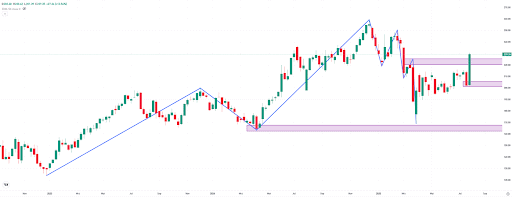Cut Me In: The Stocks That Love a Rate Cut
Markets have spent most of the summer playing Fed-roulette, betting on when Jerome Powell will finally blink and cut rates. The latest jobs report, which came in very weak, may have sealed the deal for September, pushing market odds of a cut above 70%. And portfolios are adapting before it lands.
These are some companies and sectors that may benefit directly from lower interest rates due to structural exposure to capital costs, consumer demand, or rate-sensitive financial models.
1. Homebuilders & Housing-Related Stocks
- Examples: D.R. Horton (DHI), PulteGroup (PHM), NVR Inc. (NVR)
- Why they benefit: Mortgage rates decline when the Fed cuts rates, boosting housing demand, affordability, and margins. Builders also borrow heavily and benefit from lower financing costs. It’s worth noting how skeptical the sell-side remains on homebuilders. DR Horton (DHI) and Lennar (LEN) are the two largest names in the group and each are covered by 21 analysts. But only 33% and 29%, respectively, recommend ‘buy’ ratings. When the technical picture improves while analyst sentiment lags, it often shows up as a favorable risk-reward picture.
2. Financials (Banks & Brokers)
- Examples: JPMorgan (JPM), Goldman Sachs (GS), Truist (TFC), Citizens Financial Group (CFG)
- Why they benefit: A steepening yield curve (short-term rates fall while long-term stay higher) improves net interest margins, and higher market activity from looser monetary conditions drives trading and investment banking revenues.
- Cyclicals & Industrials
- Examples: Caterpillar (CAT), Eaton (ETN), Freeport-McMoRan (FCX)
- Why they benefit: These sectors are economically sensitive. A rate cut signals and supports continued economic expansion, increasing demand for equipment, infrastructure, and materials.
4. Tech & Growth Stocks
- Examples: Meta (META), Broadcom (AVGO), Cisco (CSCO)
- Why they benefit: These are large-cap tech firms with predictable earnings and strong cash flow, but they have macro-linked revenue lines (advertising, enterprise spend, industrial demand). Their valuations still depend partly on discounting future cash flows, so lower interest rates increase present value, especially relevant when rates are falling from high levels. Lower rates = cheaper financing for R&D, acquisitions, infrastructure (e.g., data centers, chip fabrication, AI compute buildout). That matters for companies like Broadcom (hardware exposure), Cisco (enterprise infrastructure), or Meta (capex-heavy AI and metaverse investments). So they reflect both the growth-premium effect from falling rates and the real-economy boost that rate cuts aim to create.
The “No-Cut Club”: Companies That Can Stay Strong If Powell Stands Firm
Jackson Hole speech (August 23) is expected to mark a tonal shift from Powell toward easing but we still maintain caution on reversal risks. If inflation stays sticky or the Fed flexes its “independence” muscle, the Fed could hold and a different group of stocks could take the lead. These companies may be better positioned for a higher-for-longer interest rate environment, often because of stable demand, pricing power, or ties to inflation and employment.
1. Employment-Levered Firms
- Examples: ADP, Workday (WDAY)
- Why they benefit: A strong labor market supports demand for HR, payroll, and enterprise software services. These firms are revenue-levered to robust job growth, which implies no immediate Fed easing.
2. Consumer Staples
- Examples: Mondelez (MDLZ), General Mills (GIS), Altria (MO), Philip Morris (PM)
- Why they benefit: Defensive sectors outperform in uncertain macro environments. High inflation tolerance and pricing power make them resilient in a no-cut or delayed-cut scenario.
3. Inflation Beneficiaries
- Examples: McKesson (MCK), Waste Management (WM), Freeport-McMoRan (FCX)
- Why they benefit: These companies have exposure to commodity pricing, essential services, and healthcare, sectors that tend to keep pace or outperform when inflation is persistent and rates stay elevated.
In sum, if the Fed cuts, sectors like homebuilders, financials, and growth stocks stand to benefit from cheaper capital and stronger demand. If rates hold, the advantage shifts to employment services, consumer staples, and inflation hedges thanks to their defensiveness and pricing power.
MAG 7 Still the Growth Engine But It’s Getting Lonely at the Top
While the “Magnificent 7” continue to power ahead with net income growth, the broader S&P 493 is losing steam. In Q2 2025, net income for the MAG 7 is estimated to grow +25.6%, while the rest of the index (S&P 493) is forecasted to rise just +1.8%.
The gap is most stark when isolating the Big Four (Microsoft, Amazon, Alphabet, and Meta), which are spending aggressively, nearly $95 billion in capex last quarter alone to dominate the AI race. Their combined full-year capex forecast has now surged to $364 billion, up 12% from prior estimates. That level of spending would have rivaled government stimulus pre-COVID.
Looking ahead, growth prospects for the S&P 493 are uninspiring, with consensus forecasting just +2.6% and +3.0% net income growth in Q3 and Q4, respectively. With valuations elevated, the lack of breadth in earnings momentum could pose risks to the broader market narrative in the second half of 2025.

US Rate Cut Priced In, All That’s Missing Is Confirmation
The prospect of falling interest rates in the US is currently the dominant theme in financial markets. At present, the market is pricing in three rate cuts by the end of the year, with the probability of a cut in September at 89%. However, these expectations may be somewhat premature. Since the Federal Reserve acts data-dependently, the Consumer Price Index (CPI) on Tuesday takes on particular significance.
A weaker-than-expected inflation rate could further fuel the rally in U.S. equities. A higher than expected value, on the other hand, would likely dampen rate cut hopes. In that case, investors could shift to taking profits in the short term. Given the strong upward movement since the April lows, a general pullback of 3% to 5% or more from the record highs would hardly be unusual. All it needs is the right trigger. Core inflation currently stands at 2.9%, still well above the Fed’s 2% target. Further progress is needed to truly justify rate cuts. The forecast for July points to an increase to 3.0%.
For the US, the ideal scenario would be an environment where growth slows moderately but tariffs do not fuel inflation. In that case, the Fed could lower rates without concern. A recession would be avoided, while government debt could be financed more cheaply. In such a “goldilocks scenario” stocks in sectors like technology, communication services, and real estate could emerge as top performers. These sectors are considered especially interest-rate sensitive, while also offering long-term growth potential.
Strong Week for Apple: Trend Reversal or Just a Temporary Rally?
Apple stock has posted an impressive comeback, rising 13.5% over the past week to close at $229.35. Since its April low of $168.96, the stock has now gained over 36%, marking not only a robust recovery but also a potential technical trend reversal.
With the break above the previous resistance level at $224.83, the prior pattern of lower highs and lower lows has been decisively broken. This shift suggests growing momentum and a change in market sentiment. As a result, the former lower highs from the medium-term downtrend now serve as potential upside targets, namely at $249.49 and $259.61, the latter representing Apple’s all-time high.
Thanks to this strong rally, the drawdown from the record high has narrowed to just 11%. Meanwhile, on the downside, the $224.83 breakout level and the recent low at $201.20 from two weeks ago now act as important short-term support zones.

Apple stock in the weekly chart. Source: eToro
Two Trading Zones for GBPUSD
GBPUSD rose by 1.3% last week to 1.3451, fully recovering the previous week’s losses. The weekly chart highlights two key Fair Value Gaps (FVGs), which may serve as potential zones for either trend continuation or reversal:
- Zone 1 (1.3144–1.3233):
Successfully defended three times, most recently two weeks ago – considered support. - Zone 2 (1.3503–1.3562):
Last held three weeks ago – potential resistance.
Currently, GBPUSD is trading right between these two FVG zones. What matters now is which zone the market approaches next, and how it reacts there. Patience is key. Traders should wait for clear price reactions and confirmation signals before entering or exiting positions.
Since markets are fractal, this concept can also be applied to lower timeframes. Regardless of timeframe, it’s worth noting that a packed macro calendar this week – especially data releases from the UK and the US – could act as key drivers for price movement.

GBPUSD in the weekly chart. Source: eToro

This communication is for information and education purposes only and should not be taken as investment advice, a personal recommendation, or an offer of, or solicitation to buy or sell, any financial instruments. This material has been prepared without taking into account any particular recipient’s investment objectives or financial situation and has not been prepared in accordance with the legal and regulatory requirements to promote independent research. Any references to past or future performance of a financial instrument, index or a packaged investment product are not, and should not be taken as, a reliable indicator of future results. eToro makes no representation and assumes no liability as to the accuracy or completeness of the content of this publication.






